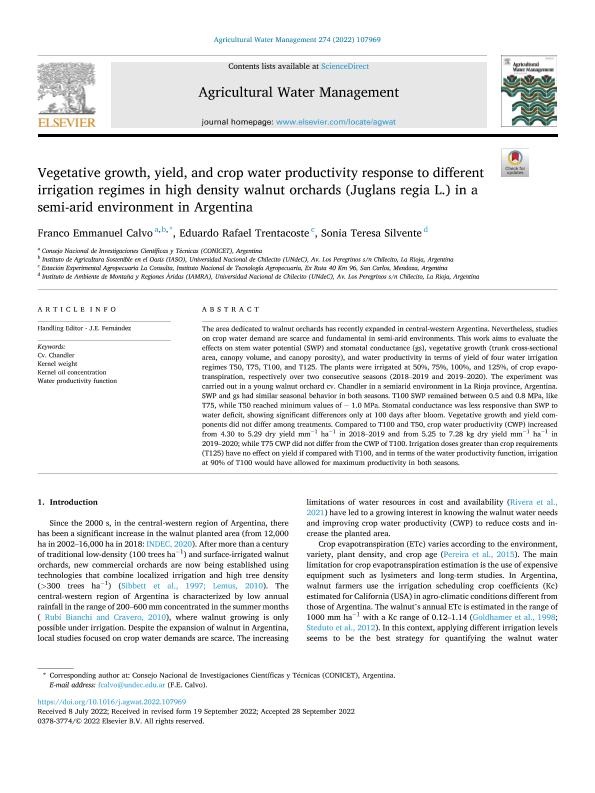Mostrar el registro sencillo del ítem
dc.contributor.author
Calvo, Franco Emmanuel

dc.contributor.author
Trentacoste, Eduardo

dc.contributor.author
Silvente, Sonia Teresa

dc.date.available
2024-01-24T15:51:05Z
dc.date.issued
2022-12
dc.identifier.citation
Calvo, Franco Emmanuel; Trentacoste, Eduardo; Silvente, Sonia Teresa; Vegetative growth, yield, and crop water productivity response to different irrigation regimes in high density walnut orchards (Juglans regia L.) in a semi-arid environment in Argentina; Elsevier Science; Agricultural Water Management; 274; 12-2022; 1-7
dc.identifier.issn
0378-3774
dc.identifier.uri
http://hdl.handle.net/11336/224741
dc.description.abstract
The area dedicated to walnut orchards has recently expanded in central-western Argentina. Nevertheless, studies on crop water demand are scarce and fundamental in semi-arid environments. This work aims to evaluate the effects on stem water potential (SWP) and stomatal conductance (gs), vegetative growth (trunk cross-sectional area, canopy volume, and canopy porosity), and water productivity in terms of yield of four water irrigation regimes T50, T75, T100, and T125. The plants were irrigated at 50%, 75%, 100%, and 125%, of crop evapotranspiration, respectively over two consecutive seasons (2018–2019 and 2019–2020). The experiment was carried out in a young walnut orchard cv. Chandler in a semiarid environment in La Rioja province, Argentina. SWP and gs had similar seasonal behavior in both seasons. T100 SWP remained between 0.5 and 0.8 MPa, like T75, while T50 reached minimum values of − 1.0 MPa. Stomatal conductance was less responsive than SWP to water deficit, showing significant differences only at 100 days after bloom. Vegetative growth and yield components did not differ among treatments. Compared to T100 and T50, crop water productivity (CWP) increased from 4.30 to 5.29 dry yield mm−1 ha−1 in 2018–2019 and from 5.25 to 7.28 kg dry yield mm−1 ha−1 in 2019–2020; while T75 CWP did not differ from the CWP of T100. Irrigation doses greater than crop requirements (T125) have no effect on yield if compared with T100, and in terms of the water productivity function, irrigation at 90% of T100 would have allowed for maximum productivity in both seasons.
dc.format
application/pdf
dc.language.iso
eng
dc.publisher
Elsevier Science

dc.rights
info:eu-repo/semantics/openAccess
dc.rights.uri
https://creativecommons.org/licenses/by-nc-nd/2.5/ar/
dc.subject
CV. CHANDLER
dc.subject
KERNEL OIL CONCENTRATION
dc.subject
KERNEL WEIGHT
dc.subject
WATER PRODUCTIVITY FUNCTION
dc.subject.classification
Agricultura

dc.subject.classification
Agricultura, Silvicultura y Pesca

dc.subject.classification
CIENCIAS AGRÍCOLAS

dc.title
Vegetative growth, yield, and crop water productivity response to different irrigation regimes in high density walnut orchards (Juglans regia L.) in a semi-arid environment in Argentina
dc.type
info:eu-repo/semantics/article
dc.type
info:ar-repo/semantics/artículo
dc.type
info:eu-repo/semantics/publishedVersion
dc.date.updated
2024-01-18T14:17:40Z
dc.journal.volume
274
dc.journal.pagination
1-7
dc.journal.pais
Países Bajos

dc.journal.ciudad
Amsterdam
dc.description.fil
Fil: Calvo, Franco Emmanuel. Universidad Nacional de Chilecito; Argentina. Consejo Nacional de Investigaciones Científicas y Técnicas; Argentina
dc.description.fil
Fil: Trentacoste, Eduardo. Instituto Nacional de Tecnología Agropecuaria. Centro Regional Mendoza-San Juan. Estación Experimental Agropecuaria La Consulta; Argentina
dc.description.fil
Fil: Silvente, Sonia Teresa. Universidad Nacional de Chilecito; Argentina
dc.journal.title
Agricultural Water Management

dc.relation.alternativeid
info:eu-repo/semantics/altIdentifier/url/https://www.sciencedirect.com/science/article/pii/S0378377422005169
dc.relation.alternativeid
info:eu-repo/semantics/altIdentifier/doi/https://doi.org/10.1016/j.agwat.2022.107969
Archivos asociados
